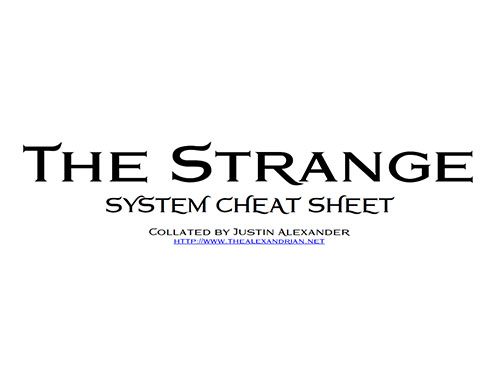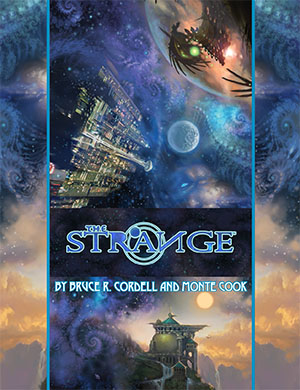The Strange is the new RPG from Monte Cook Games. The basic concept of the game looks something like this:
You may be familiar with the Fermi Paradox, the mysterious paradox which exists between the fact that conditions for intelligent life appear to be plentiful while intelligent life itself appears to be extremely rare. What we’ve discovered is that another scientific mystery — the existence and source of dark energy — is not so much a mystery as it is a smoking gun. We now know several key things about dark energy:
- It forms a vast network which exists as a fractal substrate beneath the surface of reality as we understand it.
- This network is, in fact, artificial. We don’t actually know why it was built, but we can tell that it’s the result of alien technology we can’t even begin to understand. This network is commonly referred to as the Strange.
- The dark energy within this network is drawn to sentient life. When large populations of sentient life are present (like, say, a world with 7 billion people living on it) the concentration of dark energy rises precipitously.
- Large concentrations of dark energy within the network cause the spontaneous creation of alternate realities based on the collective subconscious of the population. These realities are recursive instantiations of the “prime world” and have become referred to as “recursions”.
- Unfortunately, large concentrations of dark energy also attract the attention of beings we refer to as “planetovores”. We refer to them by that name because the first time we encountered one, it attempted to eat the planet.
Other threats to humanity also exist in the Strange or emanate from recursions. For example, one of the many recursions in the shoals of Earth is the world of Ruk. It turns out, however, that Ruk is not a recursion of Earth: It was actually spawned from an alien world and then cast adrift through the Strange. Many people on Ruk, however, don’t like being stuck in Earth’s “gravitational pull” within the Strange and want to escape. Unfortunately, the only way they know of accomplishing that is to blow up the planet.
I’m still processing all the awesome material that’s been coming out for The Strange since the beginning of August, but I’ve also been running demo scenarios for Monte Cook Games. (I’ve run those scenarios for 20+ people now.) As a result, I’ve prepped one of my system cheat sheets for the game. This actually proved relatively simply, since the mechanics of The Strange are virtually identical to the mechanics in Numenera. (Somewhere on the order of 99.99% identical.) Where the system differentiates itself are the character creation mechanics (which use the same structure, but with a completely different set of content) and the incredibly clever mechanics by which you “translate” from one recursion to another. (The short version is that all characters in the system are summarized by their type, descriptor, and focus. For example, you might be a graceful paradox who solves mysteries. When you translate from one recursion to another, the core of your character — your type and your descriptor — remains the same. But as you are translated into the symbolic reality of the recursion, your focus changes. So the graceful paradox who solves mysteries on Earth becomes a graceful paradox who embraces Qephilim ancestry on Ardeyn and a graceful paradox who metamorphosizes on Ruk. It looks simple, but in actual play this simple mechanic — and the clever character sheet that makes implementing it a breeze — is addictively awesome.)
HOW I USE THE CHEAT SHEET
As with my other system cheat sheets, this one is designed to summarize all the rules of the game — from basic resolution to advanced combat options. I’ll make stapled copies of these sheets available to the players and also keep a copy behind my screen for quick reference: Serving as a comprehensive system reference, the sheets cut down on the amount of time required for rulebook references. The organization of information onto the cheat sheets should, hopefully, be intuitive. The actual sequencing of the pages is mostly arbitrary:
Page 1: For The Strange, the difficulty table is the heart of everything. Once you understand that, the special rolls, GM intrusion, and the concept of advantage/disadvantage 90% of the rest of the system actually becomes irrelevant. This page is likely to become superfluous quickly. You’ll note that I included examples of GM intrusion: This is unusual for my cheat sheets, but so much of the Cypher System is designed to empower strong, flexible rulings by the GM that providing this kind of idea fodder feels right to me and has proven useful during play.
Page 2: The core of the combat mechanics. If you’re teaching new players the game, you really only need to walk them through these first two pages. (I’ve been adding another column or so of additional material at the beginning of each subsequent section, slowly adding more tools to the players’ toolboxes.)
Page 3: The extended combat actions and options. The rules for “Trading Damage for Effect” are technically an optional rule, but I’ve found them too invaluable not to include here. (Compared to the draft version of the sheet, you may also notice that I’ve pulled out the guidelines for simplifying multiple enemies and the boss package you can use to buff NPCs. Very useful stuff for the GM that’s buried deep in the rulebook.)
Page 4: A collection of miscellanea. Optional rules are off on the right, but I haven’t used them yet in my own game. (You’ll also note a couple of house rules tucked down in the corner. These are still being playtested, but I think they’re useful.)
Page 5: Everything that you need to know about cyphers and the Strange. The big thing here are the translation mechanics, which you can use to really emphasize the important difference between translating through the recursions of the Strange and the kind of “teleportation” effect that players might be imagining from shows like Sliders or Stargate SG-1.
Page 6: Hazards & Combat modifiers. ‘Nuff said.
MAKING A GM SCREEN
These cheat sheets can also be used in conjunction with a modular, landscape-oriented GM screen (like the ones you can buy here or here).
Personally, I use a four-panel screen and use reverse-duplex printing in order to create sheets that I can tape together and “flip up” to reveal additional information behind them. For The Strange this is pretty straightforward. My screen looks like this:
- Page 1: Basic Mechanics (nothing behind it)
- Page 2: Combat (nothing behind it)
- Page 3: Combat Actions (nothing behind it)
- Page 4: Miscellaneous Rules, with The Strange printed on the opposite side and Hazards & Combat Modifiers behind it.
PLAY THE STRANGE
My only regret right now is that I’ve got enough gaming projects on my plate right now that I don’t know when I’ll be able to prep anything for The Strange beyond the introductory scenario and the demo scenario I’ve been running. But, like Numenera before it, this game already has my official “I Had a Ton of Fun Running That” seal of approval. So I recommend grabbing a copy ASAP and digging in.
FURTHER READING
The Art of GM Intrusions
The Strange: Fictional Linkage
The Strange: Violet Spiral Gambit
The Strange: Eschatology Code – Prep Notes
The Strange: Mastodon – Prep Notes














Hey Justin! This is Richard, one of the players from your Eschatology Code game last Saturday. Just wanted to thank you again for a great time playing a great game! I picked up my copy of The Strange on Sunday, and I’ll be looking forward to going through the book and running a game of my own, hopefully someday soon! 🙂
Clicking the cover of the book at the end of the post just brings me back to this page…
@d47: Fixed! Thanks.
@Richard: It’s great to hear that you had a good time! Chris, who was sitting across the table from you, just pinged me on Twitter. So apparently we were doing something right during that session. 😉
Interesting. The concept reminds me of Terry Pratchett & Stephen Baxter’s The Long Earth (excellent book by the way – it is really nice to read some ‘optimistic’ sci-fi once in a while).
That cheat sheet is a thing of pure beauty, and I’m sure it will come in very handy. Unfortunately, The Strange rulebook is sorely lacking in this department.
Any chance of a character sheet for The Strange coming up?
MCG’s relationship with character sheets is a little baffling to me: They’ve removed download links for a high quality version of the Numenera character sheet. And, as you note, they haven’t actually gotten any version of the character sheet for The Strange available online.
With that being said, there is a character sheet in the back of the core rulebook. If you’ve got the PDF, it’ll be in there.
Character sheets for The Strange.
On “The strange system cheat sheet”
– (Increase Task difficulties by 1 Step for 1 round/enconter) is obviously about being “Distract” & “Impair” Only whereas your layout suggests it’s applied to all Minor/ Major effects
The intention with the layout is to provide a general guideline for what a minor/major effect should be able to accomplish. What I found in my early games is that people were often undervaluing major effects: They were shying away from stuff that could have an impact for the rest of the encounter.
You are correct that those guidelines should not be applied in addition to another major effect.
Justin, I just want to say thank you for all of the great information on your web site! I’ve nabbed your cheat sheets for Numenera and The Strange, and I anticipate they’ll make running my first game much easier. Thanks for sharing these with us.
Thank you for your invaluable cheat sheet. Monte Cook Games are worthwhile: a simple system with a grab-bag of abilities, revisions, moves, twists, and cyphers, that act like a colourful spell-list from you-know-what, all held together by the colourful descriptions of a novel and adventure-module master.